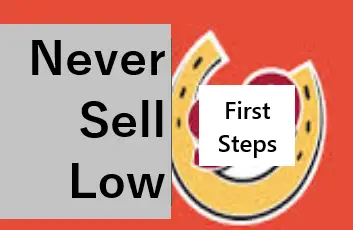Never Sell Low
My first advice as the first step of investing is never to sell low.
Asset allocation is the most important decision an investor has to make after deciding to invest. Still, a first step before that is understanding the very important rule of investing: Never Sell Low.
Never sell low! If you can avoid selling low—as a buy-and-hold investor—you will do quite well in the long run.
Why do people sell low? If people don’t understand asset allocation, then they are in trouble.
But even before that, to never sell low, you must understand that there will always be market crashes. Market crashes are a feature, not a bug of the stock market, just like recessions are a feature, not a bug of the economy. The market doesn’t always go up.
And perhaps most importantly, people sell low because of fear and greed.
So, how do you never sell low?
Never Sell Low in Accumulation
First, let’s look at your accumulation phase. Here, you convert your human capital into money, and if you save some money, you convert your money into assets for future use.
Since you are saving for the future, why would you ever sell low?
Why do people sell low in accumulation? They don’t understand that volatility is not risk.
If you are young and saving but not investing the real risk is that inflation will eat away at your purchasing power. So you MUST invest in something. The risk is mattress stuffing or staying in cash. You lose to inflation and can never meet future income needs.
Volatility is not a risk to the young buy-and-hold-dollar-cost-averaging low-cost broadly diversified investor.
A Feature, not a Bug
Next, volatility is a feature, not a bug, of the stock market. People who confuse volatility and risk provide the equity risk premium (that is why stocks pay more than the risk-free rate and why we invest in stocks in the first place).
If you are a buy-and-hold investor with time, you will out-earn inflation and be rewarded. There is no 15-year period in history where, despite an immense amount of volatility, the market is risky.
The only way you lose over an extended period is if you are forced to sell low. Never Sell Low. Thus, understand that volatility will happen and the market won’t go straight up.
If you don’t need the money, that’s not even a problem, right?
Stock market crashes are normal. They are the price of admission and why you make money on investing. During market volatility and market crashes, those who sell low transfer their money to those who Never Sell Low. Instead, keep throwing the money into the seemingly endless pit, and you will be rewarded. Dollar-cost average, rebalance, rinse, and repeat.
When you are young, volatility and crashes are not risky; they are opportunities to ensure that you will have a well-funded future. It’s scary sometimes but not risky.
Next, let’s talk briefly about deaccumulation.
Never Sell Low in Deaccumulation
The young, in accumulation, celebrate rather than fear crashes. Dollar-cost average into stocks at lower prices. Rebalance if you want.
When you are de-accumulating, however, market crashes are a bird of a different feather. For those withdrawing funds from their nest egg, a market crash is a real risk with a different moniker: Sequence of Returns Risk.
While I have written quite a bit about sequence of returns risk, it is easy to overcome if you plan. Remember: Never Sell Low.
You can de-risk before retirement. Increasing your bond allocation (go conservative) before retirement to avoid sequence risk. The goal: never sell low in deaccumulation. Have at least 3-7 years (or even 10 years) of non-stock assets to get you through the worst times.
The key to never selling low in de-accumulation is to understand that volatility happens, and it is only that important around retirement (when the sequence of returns risk is the highest).
Or why not oversave? If your withdrawal rate is 2 or 3%, your asset allocation doesn’t matter. But then, of course, you have other problems, like spending money on retirement.
So, why do people sell low?
Why Do Folks Sell Low?
So, why do folks sell low?
Emotion
Emotional investors sell low. Don’t charge off the hill with the other lemmings. Don’t watch the news. Seriously.
Emotions drive the investing cycle for individual investors. You don’t bother with the crankiest market cycles if you are a buy-and-hold investor. When do you need the asset? Never sell low because of emotion.
Need
What do you do if you need money and the market is down?
The key to never selling low: don’t ever need to! Instead, have a plan (emergency fund, etc.) and plan for sequence of returns risk at least five years before retirement.
The best time to go conservative before retirement is the day before the market crashes. The second-best time to start is about five years before your retirement date. After that, never “need” to sell stocks; you will never sell low.
Never Sell Low
Fear and greed. That’s why people sell low.
Watch for unnecessary fear about market crashes and recessions, and on the flip side, watch for greed and FOMO.
Use the flip side of fear and greed. You don’t need to fear stocks; they go up in the long run despite volatility and crashes. You don’t need to be greedy, either. Take what you can get. You can get the market average using low-cost, diversified index funds. By doing that, you will usually beat the greedy crowd, anyway.
